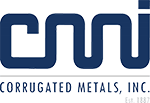The railway industry stands as one of the cornerstones of modern transportation, connecting people, goods, and economies across vast distances. As this sector continues to evolve, innovative materials and construction methods are sought to improve efficiency, increase durability, and reduce maintenance demands. Corrugated metals have emerged as a remarkable resource in this endeavor, offering a range of benefits — durability and longevity, resource efficiency, energy savings, and reduced maintenance needs — that make them an ideal choice for various railway applications. From tracks to stations, bridges to rolling stock, the use of corrugated metals brings forth a new vision of efficiency and sustainability.
Let’s look at several of the reasons why.
An efficient, effective resource
Resource consumption, energy usage, and waste generation are concerns within the railway industry, warranting sustainable solutions. The sheer scale of resource consumption, from raw materials required for tracks and infrastructure to those essential for rolling stock manufacturing, is a significant environmental challenge. Traditional construction materials like concrete and wood demand extensive natural resources, contributing to natural habitat degradation and deforestation.
By promoting longevity, minimizing waste, and supporting recycling efforts, corrugated metals stand as a sustainable solution that contributes to the long-term resilience and eco-friendliness of the railway industry. They are an eco-friendlier material choice due to:
Energy savings: From the beginning to the end of its lifecycle, metal puts less strain on valuable resources. The manufacture of corrugated metals boasts an inherent advantage in terms of energy efficiency when compared to the production of many other railway materials. The process involves shaping and forming thin sheets of metal through rolling and pressing techniques. These methods require less energy input compared to the complex procedures associated with materials like concrete or composite materials.
The ability to reuse corrugated metals, coupled with the energy savings achieved during production, makes a compelling case for their integration into the railway industry. This not only aligns with modern sustainability goals but also contributes to a more environmentally conscious railway network.
Waste concerns: In addition to resource consumption, waste generation is a critical issue that requires immediate mitigation strategies. The construction, maintenance, and decommissioning of railway infrastructure generate significant amounts of waste, ranging from construction debris to discarded equipment. Traditional materials such as concrete and timber, when replaced, lead to substantial waste disposal challenges.
Rolling stock maintenance and upgrades also result in the accumulation of discarded components, contributing to landfills and adversely affecting local ecosystems. These waste management issues underscore the need for materials that minimize waste and can be recycled or repurposed, aligning with the broader goals of sustainable development within the railway industry.
Durability and longevity: Railway systems are exposed to a wide array of environmental factors, from extreme weather conditions to heavy loads and vibrations. Corrugated metals, with their proven durability, offer robust protection against these challenges. The unique corrugated design increases the material’s strength by distributing stress evenly across its surface. This structural advantage ensures that the metals can withstand the pressures of constant train movement, preventing premature wear and tear. As a result, railway infrastructure crafted from corrugated metals enjoys a longer lifespan compared to traditional materials.
The longevity of railway infrastructure is crucial to the sustainability of transportation networks. Corrugated metals offer a promising solution to this challenge. Their innate resistance to wear and tear, combined with the ability to withstand heavy loads, ensures that structures built with these materials can endure for generations. This longevity not only reduces the need for frequent replacements but also contributes to a more sustainable and eco-friendly railway system by minimizing waste and resource consumption.
Reduced maintenance needs
Maintenance is an integral part of railway management, consuming both time and resources. Corrugated metals alleviate this concern due to their low-maintenance nature. Their resistance to corrosion, rust, and deterioration makes them an attractive option for outdoor applications where exposure to moisture and harsh elements is inevitable. By requiring minimal maintenance, railway operators can redirect their resources towards more pressing tasks, leading to increased operational efficiency and reduced expenses.
Innovative Applications
Corrugated metals are not limited to just railcars and bridges. Their versatility allows them to be used in various railway-related applications that are crucial to smooth, safe railways. Along the tracks, corrugated metals are ideal for structures such as trackside barriers, bridge supports, culverts, and more. But the uses don’t stop there.
Train carriages, stations, and even architectural elements of railway facilities can benefit from the strength and aesthetic appeal of corrugated metals. Their adaptability to different design styles, whether modern or classic, makes them an attractive choice for architects and designers seeking to merge functionality with visual appeal.
Final thoughts
The railway industry continues to evolve, driven by the need for efficiency, durability, and sustainability. Corrugated metals have emerged as a vital resource in this evolution, offering many advantages that support these environmentally conscious requirements. From their energy-efficient construction process to their incredible durability that ensures a longer lifespan, corrugated metals are essential for a new era of railway infrastructure. As the industry grows and innovates, corrugated metals are a means of keeping our environment and resources in mind and supporting the pursuit of excellence in transportation systems.
As a leader in corrugated metals, CMI has decades of experience within the railway industry. If you would like to discuss your railcar or infrastructure needs, get in touch with us. With our extensive roll forming (and other) capabilities, we are confident we can effectively meet your specific needs

